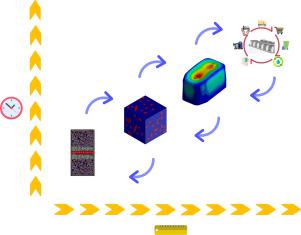Sustainable Materials and Technologies ( IF 8.6 ) Pub Date : 2021-07-26 , DOI: 10.1016/j.susmat.2021.e00327 Andrea Mio 1 , Serena Bertagna 2 , Luca Cozzarini 2 , Erik Laurini 1 , Vittorio Bucci 2 , Alberto Marinò 2 , Maurizio Fermeglia 1

|
One of the major challenges of Life Cycle Assessment is in the generation of life cycle inventories for complex or novel materials. This paper aims at broadening the perspective in Life Cycle Assessment methodology, exploiting multiscale modelling towards the generation of inventory data during an early-stage product design. Our approach involves the usage of molecular modelling techniques, such as electronic, atomistic or mesoscale models, in combination with continuum models, such as process simulation or finite element methods, to provide data for the generation of life cycle inventories of nanostructured materials. In particular, each simulation is performed at a specific length and time scale through specific software, passing information from the lower to the upper scale. We applied our procedure to a comparative Life Cycle Assessment among suitable materials for the production of a set of cylinder head cover of a marine engine, i.e., aluminium alloys and nano-engineered thermoplastic polymers. Engineering judgment, Ashby charts and maritime regulations led the initial identification of suitable materials. As a result, polyamide 6,6 reinforced with 30% wt. glass fibers and mixed with phosphate-based flame retardants have been identified as promising candidate for the replacement of aluminium traditional covers. Nonetheless, we introduced nanoclays, i.e., exfoliated montmorillonite, as a replacement for a quota of conventional flame retardant, aiming at reducing the usage of pollutant chemicals. We then resorted to atomistic and finite-element techniques to investigate the compliance of nanocomposite materials with several Key Performance Indicators. The nanocomposite formulations obtained from simulations have been finally employed as input data for life cycle inventories of material alternatives. Using a Life Cycle Assessment approach, we could identify the most environmental-friendly nanocomposite formulation, which was then compared with traditional aluminium through an additional comparative cradle-to-grave study. Among the suitable nanocomposite formulations, the material with the minimum amount of traditional flame retardant exhibited the lowest scores among the majority of Environmental Footprint impact categories. To account for the entire lifetime of the marine engine, a set of four nanocomposite covers has been compared with a set of three aluminium covers made by two different metal alloys. Four recycling scenarios for aluminium covers have been examined, assuming an incremental number of end-of-use products reintroduced into a circular life cycle, while nanocomposite ones were disposed into landfill. In turn, if the aluminium products are insufficiently recycled, our results promote the usage of nano-engineered polymer products. As the amount of reused metal covers increases, indeed, polymer-based covers become unfavorable with respect to aluminium cast alloy products. Accordingly, an increasing amount of post-consumer aluminium diminishes the need of primary metal, yielding considerable advantages in terms of environmental footprint. Consequently, stakeholders should commit in recycling metal components not only at ship dismantling, but also during ordinary maintenance. Our study showed how multiscale molecular modelling proved to be useful for providing necessary inventory data for complex nanostructured materials. This preliminary study paves the way for future development of the proposed framework, in which in-silico techniques based on distinct paradigms can mutually contribute towards an improvement of products ecodesign.
中文翻译:

生命周期评估中的多尺度建模技术:在海事工业中纳米结构聚合物系统的应用
生命周期评估的主要挑战之一是生成复杂或新型材料的生命周期清单。本文旨在拓宽生命周期评估方法的视角,利用多尺度建模在早期产品设计期间生成库存数据。我们的方法涉及使用分子建模技术,如电子、原子或中尺度模型,结合连续模型,如过程模拟或有限元方法,为生成纳米结构材料的生命周期清单提供数据。特别是,每次模拟都是通过特定的软件在特定的长度和时间尺度上进行的,将信息从较低的尺度传递到较高的尺度。即,铝合金和纳米工程热塑性聚合物。工程判断、阿什比海图和海事法规引导了对合适材料的初步确定。结果,聚酰胺 6,6 增强了 30% wt。玻璃纤维并与磷酸盐基阻燃剂混合已被确定为替代铝传统覆盖物的有希望的候选者。尽管如此,我们还是引入了纳米粘土,即去角质蒙脱石,作为传统阻燃剂配额的替代品,旨在减少污染物化学品的使用。然后,我们采用原子和有限元技术来研究纳米复合材料与几个关键性能指标的合规性。从模拟中获得的纳米复合材料配方最终被用作替代材料生命周期清单的输入数据。使用生命周期评估方法,我们可以确定最环保的纳米复合材料配方,然后通过额外的从摇篮到坟墓的比较研究将其与传统铝进行比较。在合适的纳米复合材料配方中,在大多数环境足迹影响类别中,传统阻燃剂用量最少的材料得分最低。为了说明船用发动机的整个使用寿命,我们将一组四个纳米复合材料盖与一组由两种不同金属合金制成的三个铝盖进行了比较。已经研究了铝盖的四种回收方案,假设越来越多的终端产品被重新引入循环生命周期,而纳米复合材料则被丢弃到垃圾填埋场。反过来,如果铝制品回收不足,我们的结果会促进纳米工程聚合物产品的使用。随着重复使用的金属盖的数量增加,实际上,聚合物基盖对于铝合金铸造产品变得不利。因此,越来越多的消费后铝减少了对原生金属的需求,在环境足迹方面产生了相当大的优势。因此,利益相关者不仅应在船舶拆解时,而且在日常维护期间都应承诺回收金属部件。我们的研究表明,多尺度分子建模证明如何为复杂的纳米结构材料提供必要的库存数据。这项初步研究为拟议框架的未来发展铺平了道路,其中 我们的研究表明,多尺度分子建模证明如何为复杂的纳米结构材料提供必要的库存数据。这项初步研究为拟议框架的未来发展铺平了道路,其中 我们的研究表明,多尺度分子建模证明如何为复杂的纳米结构材料提供必要的库存数据。这项初步研究为拟议框架的未来发展铺平了道路,其中基于不同范式的计算机技术可以相互促进产品生态设计的改进。







































 京公网安备 11010802027423号
京公网安备 11010802027423号